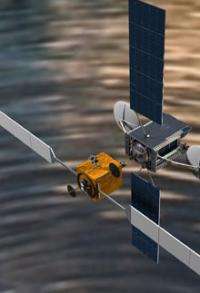May 16, 2012 report
ViviSat space vehicles will keep satellites on track

(Phys.org) -- A company that aims to sell satellite protective services is eagerly stating its business case to geosynchronous satellite operators that can benefit from its approach toward orbit mission extension. ViviSat intends to help these operators to add years to the revenue-producing life of a satellite. Having to mind one’s orbit assets is a concern that the company believes will draw new customers. The company’s CEO, Major General, U.S.A.F. [Ret.] Craig Weston, said that ViviSat was in negotiations with potential customers and that market conditions for such services were strong. Weston is the head of U.S. Space; he has spent a large part of his career operating communications, infra-red warning, and reconnaissance satellites.
The company has been designing a space vehicle that can adjust an older satellite's orbit, rescue fully fueled satellites that may have launched into the wrong location, or move a satellite into a different orbit for a completely new purpose.
ViviSat’s device is a Mission Extension Vehicle (MEV) with the purpose of safely connecting to an orbiting satellite to provide supplemental and propulsive capabilities.
The MEV uses a space-ready docking system and integrated proximity sensors to rendezvous with the host satellite. ViviSat’s MEV does not add fuel or remove any materials on the satellite itself, however, but the company notes this is an advantage, not limitation. For customers in need of an MEV that would be less intrusive, its vehicle allows satellite operations to continue uninterrupted even with the MEV attached.
“Satellites were designed to not be tampered with, and this is a passive approach, which is appealing to operators," said Edward Horowitz, company chairman of the board. Horowitz is co founder of U.S. Space and former CEO of SES Americom.
Two entities, U.S. Space and ATK Space Systems, created ViviSat, which was announced last year. U.S. Space takes care of business and mission management. ATK is the prime contractor, responsible for the manufacture and delivery of the spacecraft, launch and ground segments. (ATK manufactured reusable solid rocket motors for NASA's space shuttles.)
Geostationary satellites perform continuous monitoring of a specific region. ViviSat’s confidence in serving a market need is supported by the fact that, “If you just look at the commercial market, there are 350 to 360 satellites in geostationary orbit,” said Horowitz in SPACE.com, of which about 25 each year reach the end of their fuel life. He said that out of those 25, “we figure 10 are good target customers for this.” The company sees its market opportunities lie in both commercial and government spacecraft.
Horowitz said, "We're ready to sell, we're ready to build, we're ready to deliver."
More information: www.vivisat.com/?page_id=10
© 2012 Phys.Org




















